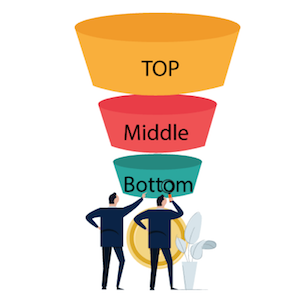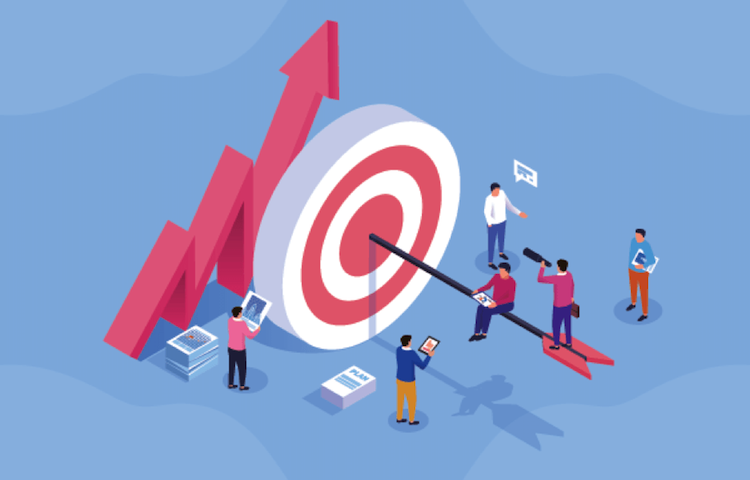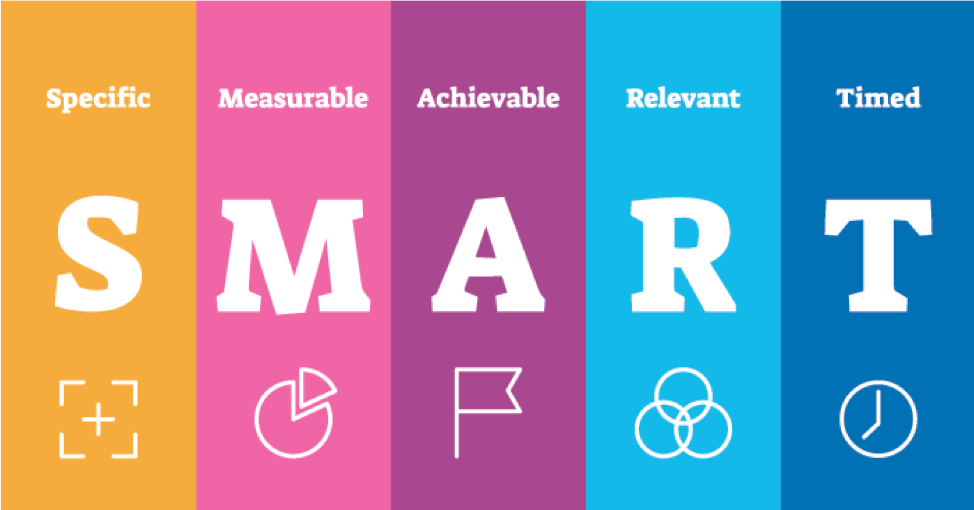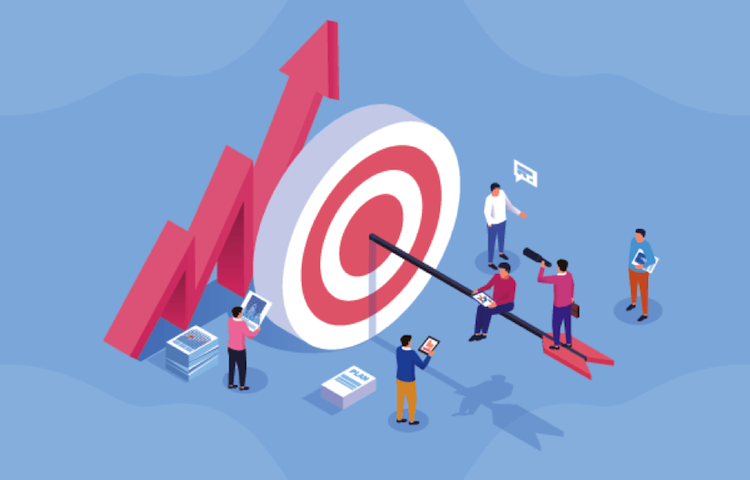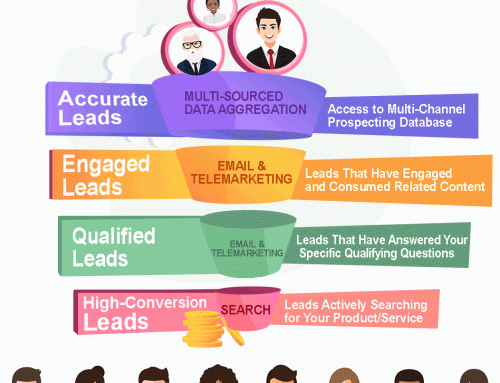With an effective lead generation strategy, your company can get 133% more revenue than you’ve planned. (Marketo)
Lead generation marketing has become more challenging in today’s globally competitive marketplace. Businesses flood consumers with information every day, offering their products and services. Today’s marketer must figure out how to rise above the clutter to connect with buyers.
Traditionally, marketers relied on outbound marketing strategies such as mass advertising or blanket email campaigns. Now, they must utilize inbound marketing tactics and create custom content that is tailored and personalized to their audience. For b2b buyers who must go through various approval stages, that could mean a long customer journey through the marketing funnel.
What is Lead Generation?
Any individual interested in a company’s product or service is considered a lead. Lead generation is the process of attracting leads to your business and growing their interest through nurturing, all with the end goal of converting. Lead generation is not always a one-step process. It requires taking potential customers down the sales funnel until they’re ready to buy. For lead generation programs to be effective, you need to generate qualified leads that are likely to become customers.
According to Ruler Analytics, 91% of marketers say that lead generation is their most important goal. And 53% of marketers spend at least half of their budget on lead generation.
A strong lead generation program will increase brand awareness, build relationships, generate qualified leads, and in the end, close deals. The higher the quality of leads you give to your sales team, the more those leads will result in sales. While successful lead generation helps your company grow, it also boosts the credibility of your marketing department by showing tangible results and proving that the marketing department is a valuable part of the revenue team.
Lead Generation vs. Sales Prospecting
You’ve probably heard the terms lead generation and sales prospecting interchanged but is there a difference between lead generation and sales prospecting? Lead generation and sales prospecting have the same end goal – to convert a lead into a customer, but the approaches are different. Sales prospecting is more one-on-one, for instance, cold calling. You use sales prospecting to identify, engage and close new clients quickly. The sales team usually does sales prospecting. Lead generation takes more time and includes nurturing the lead until the lead is ready to buy, and the process is generally handled through marketing using marketing automation software.
What is a Marketing Sales Funnel?
A marketing sales funnel is the journey potential customers go through to purchase, from start to finish. There are several lead generation steps to a marketing funnel, usually broken down as the funnel’s top, middle, and bottom. Still, there may be more depending on the company’s sales model.
Top of the Funnel
The top of the marketing funnel is the first stage of the buyer’s journey, where lead generation starts. The customer is still only discovering your brand and is not ready to purchase yet. At the top of the funnel, it’s ideal for getting as many leads as possible and then narrowing them down as they proceed through the funnel.
At the top of the funnel, marketers will want to provide potential customers with general information about their company. Here, you want to start building trust with your potential customers. This is called the awareness phase. Keep your customers’ pain points and challenges in mind and deliver content that solves their concerns.
The goal at the top of the funnel is for marketers to obtain basic contact information about their leads. You can do this through an exchange for free content. Some marketing ideas for this stage include webinars, white papers, tradeshows, live events, email campaigns, SEO, videos, and infographics. Your content should contain a strong call for action, such as download, sign up, or subscribe.
TOF is where new leads come in for the marketing department to nurture. Once you gain the lead’s attention, you move them from lead generation to lead management and progress to the Middle of the Funnel with your marketing.
Middle of the Funnel
Lead nurturing begins in the middle of the marketing funnel and is broken down into three categories: interest, consideration, and intent. A well-executed middle-of-the-funnel marketing strategy can help drive conversions and nurture long-lasting relationships.
In the interest phase, marketers should introduce more about their company’s positioning and develop relationships with the individuals in their lead database. It would be best to focus on content that depicts more about your company, its products, and its services. Some marketing ideas for lead nurturing include emails, newsletters, and retargeting. Your content should not be a hard sell but should talk about benefits and features instead.
In the consideration phase, leads have been changed into marketing qualified leads (MQL) and are seen as prospective customers. Marketers can send prospects more information about products and offers through personalized email campaigns while continuing to nurture them with targeted content, case studies, customer success stories, “how-tos,” free trials, demos, and more.
After the consideration phase, we are almost ready for the bottom of the funnel. In the intent stage, prospects have demonstrated that they are interested in buying a brand’s product. Marketers can determine this from survey results, after a product demo, or when a product is placed in the shopping cart on a website but not purchased. It is now when you should give a final push as to why your product or service is the best choice.
Bottom of the Funnel
When marketing has determined that the potential customer is ready to purchase, it becomes a sales-qualified lead (SQL) and is deemed ready for the next stage in the sales process by the sales team. You have now entered the bottom of the funnel with the last two phases: evaluation and purchase.
In the evaluation phase, buyers make a final decision about whether or not to buy a brand’s product or services. For b2b companies, that means contract negotiations. Here is an excellent opportunity to present a discount or special offer. Once someone agrees to purchase, it’s time for the final phase.
Eureka, you have reached the bottom of the bottom funnel! The purchase phase is the end of the marketing funnel, where a prospect has decided to buy and turns into a customer. At this phase, your business objective is to create a positive experience for the buyer and show them that you value their feedback so they will continue to be lifelong customers.
Why not just call every lead right away?
A whopping 73% of leads aren’t sales-ready. (Marketing Sherpa)
Companies need to develop sales leads for various reasons, including audience expansion, gaining new customers, increasing revenue, and encouraging loyalty from existing customers.
It’s a typical call that the Director of Marketing receives. The VP of Sales says that marketing is not delivering high-quality leads, wasting valuable sales time. It is crucial that the sales and marketing teams work together to determine the goals of the lead generation program and what makes a lead qualified, and when it should move from marketing to sales. You don’t want to contact the lead too early and definitely not too late. It takes time to bring in sales-ready leads, which is why lead nurturing is essential.
According to Forrester, buyers might be anywhere from 75 to 90% of the way through their buying journey before contacting the vendor after completing their own research.
Lead nurturing is an effective method to further guide leads through the buying journey. You approach leads at specific touchpoints and offer new relevant content. During lead nurturing, scores are given to each lead based on their interaction with the content. Leads with a high score move to sales and leads with low to medium scores remain in lead nurturing until they are moved into sales or deemed inactive.
Companies that nurture leads generate 50% more sales at 33% lower costs. (Marketo)
Unqualified Leads vs. Qualified Leads
Unqualified leads typically haven’t displayed an interest in a company’s goods or services. If a product or service fits an unqualified lead’s needs, the marketing department will take the next lead generation step, which is to develop a relationship with the contact and convert them into a qualified lead.
A qualified lead is an individual who shows interest in a company or is more likely to become a customer in general. There are two primary types of qualified leads: marketing qualified leads (MQL), and sales qualified leads (SQL). Marketing qualified leads may show they have the potential to become a customer through interaction with a company’s content, such as: reviewing a product or service on the website or filling out a form on a company’s landing page.
MQLs often require further relationship building before deciding to become a customer. In comparison, SQLs typically reveal right away that they’re considering purchasing by asking for product pricing, adding a product to their cart, or requesting details about discounts and promotions.
Buyer personas – who do you want to attract through your lead generation program?
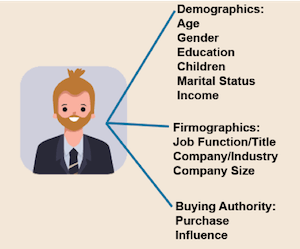
To create a successful lead generation program, it is critical that marketing and sales partner together to create buyer personas. The importance of buyer personas cannot be understated. By creating buyer personas, the marketing and sales teams know what content to deliver during the different stages of a customer’s journey. This ensures the highest ROI possible.
With the buyer personas in place, both groups can communicate more effectively by creating targeted content for each stage, with marketing taking the top and upper middle funnel and sales concentrating on the lower middle and bottom stages of the funnel.
Marking Automation and The Lead Generation Process
During the last decade, marketing automation software emerged to make the lead generation process easier. Now more than 51% of companies are using marketing automation. Marketing automation software companies such as HubSpot, Marketo, Salesforce Marketing Cloud, Salesforce Pardot, and Eloqua offer automation packages for small businesses to large companies. Marketing automation can help you generate more leads and nurturing without the time investment of traditional outreach and sales. If you haven’t already invested in marketing automation software, you may want to consider talking with a marketing automation consultant to help you choose the right software for your needs and to get you started with installation and implementation.
4 Components for a Strong Lead Generation Program
A lead generation database. You need to be able to track the leads that are coming in, attribute them to the appropriate source, score, and segment them to begin nurturing. Using an automated system for nurturing leads will help you scale your efforts and be more successful.
Content, content, and then some more content. It’s the fuel for all of your campaigns, including email, social, webinars, live events, website, and landing pages. Creating an editorial content will help to make sure you have enough content for your lead generation program and will help to keep you on track for creating the content in a timely manner necessary for the program.
A way to measure your Key Performance Indicators. With analytics, you can accurately track returns on your lead generation programs. Analytics allows you to analyze the impact of every channel you use – SEO, social media, email, and web advertising. In turn, you can identify its effect on your goals and business performance.
A martech stack. Choosing the best lead generation technologies based on your business goals will save you time money, help you do more with less, measure and optimize your programs, and in the end, allow you to grow your lead generation programs and your business faster.
Setting Goals for a Lead Generation Program
It is critical to set goals that are achievable with your lead generation programs. Key Performance Indicators (KPIs) are about focused data so you can accurately measure results. One of the best ways of evaluating the effectiveness and appropriateness of a KPI is the SMART criteria. SMART stands for Specific, Measurable, Attainable, Relevant, and Time-Bound.
How SPECIFIC is the goal? Be specific about what you want to achieve—answer who, what, where, when, and how the goals will be achieved.
Is it clearly MEASURABLE? What metrics will you use to determine if you meet the goal?
How ACHIEVABLE is it? How important a goal is to you and what you can do to make it achievable may require developing new skills and changing attitudes. Think if you have the tools/skills needed to accomplish the goals and if you currently don’t possess those tools/skills, consider what it would take to attain them.
Is it RELEVANT to the business? The goals should align with the broader business goals.
What Is the TIME Frame to achieve the objective? It’s easy to set goals, but if the goals lack realistic timing, you’re probably not going to be successful. It is critical to provide a target date for deliverables to keep the program on track and moving forward.
What are the best lead generations opportunities to fill your sales pipeline?
The most effective lead generation tactics include email marketing, content marketing, social media marketing, landing page, website optimization, and SEO.
Make sure your lead generation programs include a clear understanding of your target market, multiple marketing channels to capture and narrow down your leads, compelling offers, and a strong strategy that tracks performance. If you have all of these, you are on your way to successful lead generation! And don’t sit on your laurels when all is good. Marketers know you should always be testing to make improvements.
What is lead generation and why is it important?
Lead generation is a process that builds visibility and credibility with potential leads. It can help drive traffic from high-quality prospects, which in turn results to higher conversion rates for your business!
What is lead generation and its types?
There are two main types of lead generation-outbound and in. Out Bound Lead Generation is when you make cold calls, send direct mail or advertising materials like brochures to potential customers; while In bound method happens through SEO (search engine optimization), PPC, social media platforms such as Facebook & Twitter etc.
Who needs lead generation?
If a company is looking to generate new leads, it’s important they have an effective lead generation funnel. The reason being that most purchases take longer than just one interaction with your organization and this becomes even more true when there are various levels of marketing involved before making the final decision on what product or service someone wants from you.
How do you find leads?
- Referrals
- Current customers
- Competition
- AI Business Sales Tools
- Online Forums
- Quora
- Trade Shows
- Networking events
Trending Lead Generation Strategies
© Reach Marketing LLC 2022 All Rights Reserved.


